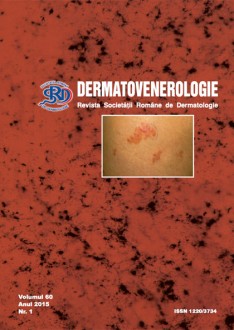Lichen scrofulosorum is a rare, paucibacillary form of cutaneous tuberculosis. Diagnosis is difficult, requiring a differentiation on both, clinical and histopathological appearance, from other common diseases such as lichen planus, lichen nitidus, sarcoidosis, syphilides, lichenoid dermatitis and other granulomatous forms of dermatitis with infectious origin. Being a paucibacillary form, the acid-fast bacilli are not usually identified on bacterial cultures or on special stains, therefore rapid mycobacterial DNA identification (PCR) technique from tissues have limited utility. The diagnosis is based on histopathological examination, associated with the confirmation of active internal TB infection. As in all cutaneous forms of tuberculosis, lichen scrofulosorum treatment follows similar principles as pulmonary tuberculosis infection, while taking into account the infection expansion and the immune status of the patient.
The case presented is of a 41 year old female patient diagnosed with lichen scrofulosorum after a 7-year history of persistent, asymptomatic eruption on trunk and face. During that time the patient received multiple diagnostic interpretations and therapeutic interventions.
The case shows clinical course particularities and is illustrative for the diagnostic difficulties of this rare form of cutaneous tuberculosis, as well as for the need to take into account this disease as a possibility, given the fact that Romania occupies one of the leading positions in Europe`s tuberculosis incidence.
Clinical cases
LICHEN SCROFULOSORUM – A RARE FORM OF CUTANEOUS TUBERCULOSIS – CASE REPORT


